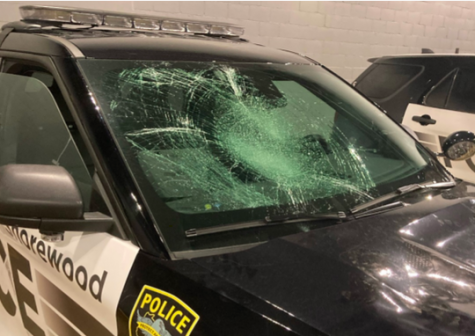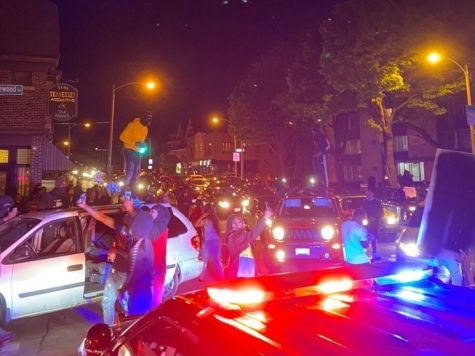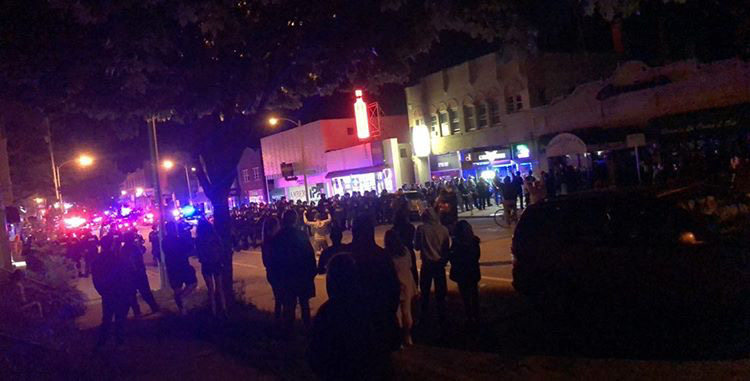Protesters prevented from entering Shorewood
What happened at Oakland Ave and Edgewood Ave, on the night of May 31, 2020.
A police line of officers in riot gear block N. Oakland Ave. This line is south of where heavy law enforcement teams were placed on the corner of Edgewood and Oakland.
On May 31, standoffs between police and protesters, at the border between Shorewood and the City of Milwaukee, erupted into frenzied arrests in the shadow of armored trucks and a heavy law enforcement presence.
According to a police report given June 1, the Shorewood Police Department “called for allowing the group of people to peacefully walk into Shorewood and the belief was they would want to walk north on Oakland to Capitol.” From photos posted by the village, police cars appear to be blocking E Oakland Ave. as it intersects with N Capitol Dr., indicating that the police wanted protesters to turn left at Capitol and go west until they left Shorewood.
The protesters and vehicles making their way north on Oakland arrived at E Edgewood Ave. – the border dividing Shorewood and the City of Milwaukee – at approximately 9:50 pm. The assumed intentions of the protesters quickly changed as they arrived at Shorewood.
The police report states that some protesters moved north on Oakland, but most vehicles and pedestrians turned east onto Edgewood, so police were “quickly redeployed to make Edgewood a safe route for the group to proceed.”
The report stated that “at no time did we prevent the group from moving,” yet the back part of the group – slowly thinning – came up against a wall, rows deep, of police officers in riot gear blocking off Oakland. This human barricade spanned the width of the street, and shuffled further south on Oakland, forcing the remaining protesters further into Milwaukee.
“It honestly seemed like the police at that point outnumbered the protesters,” Oskar Bockhorst, sophomore who witnessed the scene on the southern part of the block.
Police slowly yet forcefully shuffled against the group, pushing protesters past stores like Wade’s Guitar Shop and Otto’s Wine and Spirits. The general demeanor of the group was peaceful. Only verbal aggression towards the police line was used, but witnesses say that there were no objects thrown or projected towards police. Protesters on the front line kneeled with their hands up, a common body gesture used in peaceful protests across the country.
“Then a bunch of people in the group shouted ‘regroup’ and just kind of walked away,” Bockhorst said.
The police report is not very clear as to why law enforcement blocked off Oakland. It states that protestors, as they continued east via Edgewood and later north via N Maryland Ave, were sometimes violent. The report includes descriptions of damage and violence towards police: a squad car was found to be damaged on the corner of Edgewood and Oakland; people throwing bottles, cans, and hard objects at officers; officers recounted a man holding an unlit molotov cocktail as he pointed towards police and shouted.

The report states that police directed protesters onto N Downer Ave. “as we thought that was the best street to handle the large group.” The large group then turned south, returning into the City of Milwaukee.
As for the intersection of Oakland and Edgewood, which is about half a block north of where police lined up arm in arm to move protesters south, law enforcement came to ensure that no more protesters would enter Shorewood. Sophia Wiley, junior and participant in protests from earlier that day, went to see what was happening.

“The protest was turning [onto Edgewood] and it was just this big swarm of cops and paddy wagons,” Wiley said. “At that point the protest had already left, and there were only 30 protesters left, and there were 50-plus police officers. It was just blown out of proportion.”
There was a heavy police presence at the intersection, and squad cars from other counties arrived. At 10:27 pm, the report states that “MCSO [Milwaukee County Sheriff’s Office], Milwaukee TEU [Tactical Enforcement Unit] and MIRT [Major Incident Response Team] teams arrived at Oakland and Edgewood.” These teams were the officers who were heavily armed, heavily guarded, and in riot gear. Many mistook the police presence for the National Guard, which was not deployed to this area at the time. Governor Tony Evers had deployed the National Guard to Madison that night.
Wiley took a nearly four minute video, which circulated on social media, showing a young black man being tackled and arrested by two police officers in heavy riot gear. At one point there were five officers trying to get a hold of the person. The video shows the aggression and chaos that the police presence offered to the scene.
“[The protesters] were just chanting and holding signs, they weren’t violent whatsoever,” Wiley said.
Wiley explained what made her take the video, and the context surrounding it.
“It was right when a bunch of police came and they were all in riot gear. There’s this procedure where they push the crowd in, and some people I guess were resisting, and they just threw them on the ground and were hitting them with batons and arresting them,” Wiley said. “At that moment I felt like I had to record, because this is exactly what we’re fighting for. This is the problem that we’re facing, and [the police] are just repeating themselves over and over.”
“I couldn’t believe how they were arresting him … He had done nothing and they rushed him and just grabbed him,” said Sarah Spencer, who was also a witness to the arrest in the video. “I feel like he was just so taken off guard, and they were laying on him. And he was maybe 130 pounds.”
Many criticized the heavy police force, especially that fact that they were on the border of Shorewood. The various teams that were deployed, along with the police presence from towns and counties (West Allis, Brown Deer, and Racine) were used to keep what appeared to be 30 people out of Shorewood, a quiet and mostly white-populated suburb.
“[The police] were preventing protesters from coming into a white neighborhood. It just showed that they were protecting the white people,” Wiley said. “If you just stayed in Shorewood, you would have no idea there are protests going on. Shorewood has such a privilege to go to sleep and have silence and live among peace, and they don’t understand that.”
The night before, on May 30, Glendale police put a curfew in place because there were “credible threats to Bayshore [mall] of looting,” according to Allison Rozek, Shorewood Village Board president. The village does not yet have sufficient communication abilities to get messages to their residents quickly, like a texting or alert-based system, so the curfew was set in place.
“With the village being so small, we don’t have the same resources as the City of Milwaukee,” Rozek said. “We don’t have a really great method yet of communicating with the residents that we know of an event, whether peaceful or non peaceful, that may occur in our boundaries. So the best way to get out information is through the media, and the best way to do that, in these circumstances, is through a curfew.”
Rosek explains why there was no curfew in place for May 31, the night the protests came to Shorewood.
“There was no intel that any activity was going to happen in our borders,” Rosek said. “So we did not call a curfew.”
There was no curfew in place on May 31, even though the City of Milwaukee’s curfew alert went to all phones in the 53211 zip code.
The police made 10 arrests in total. The report does not explain why, but specified that the arrests were made “in the City of Milwaukee south of Edgewood and Oakland.” An attempt to contact the police department through email was unsuccessful.
Witnesses say the people who were arrested were merely bystanders.
“It was just the more prominent people in the crowd I think they were targeting, which has been a common theme in most of the protests,” Wiley said.
The police report just states that “at approximately 10:51 [pm], the group had moved south of Shorewood.” The report does not explain that the police had used the “push” tactic, forcing the protesters more south. The group mentioned is not specified as the group at the intersection or the group forced out by the line of police further south on Oakland, or the group of 30 protesters on the corner of Oakland and Edgewood. Other witnesses say the action ended between 11:00 pm and 11:45 pm.
*Correction: in the print edition of Ripples, issue five, it is stated that the National Guard was deployed somewhere in the City of Milwaukee on May 31. The National Guard was actually deployed to Madison, Wisconsin, as stated correctly in this online version of the article.

